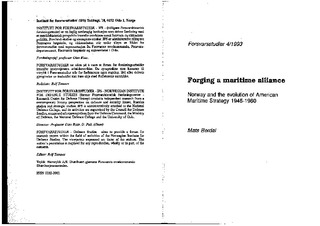Forging a maritime alliance: Norway and the evolution of american maritime strategy 1945-1960
Others

Åpne
Permanent lenke
http://hdl.handle.net/11250/99713Utgivelsesdato
1993Metadata
Vis full innførselSamlinger
- Forsvarsstudier [123]
Beskrivelse
The study examines the development of American maritime interests in the High North in the period from 1945 to 1960 with particular emphasis on the Eisenhower period and Admiral Arleigh Burke's tenure as Chief of Naval Operations. Specifically, it traces the reorientation of US concern about Soviet naval developments from the Baltic area to the Northern Fleet area after 1955. It explores how, in the latter half of the 1950s, Norway acquired a central role in US defence strategy as the US Navy - partly in response to the weakening of British naval power - moved into the Northeast Atlantic. By 1960 Norway was providing navgational support for the first generation of US nuclear-fuelled ballistic missile submarines and was playing a key part in the nuclear-oriented anti-submarine strategy of the US Navy. In 1960 the process which had begun in the late 1940s when the US increasingly came to assume Britain's traditional role as Norway's principal source of external support had been largely completed.